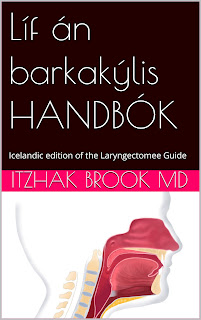Created by Itzhak Brook MD a physician and a laryngectomee. It contains information about head and neck cancer, life after laryngectomy, and manuscripts and videos about Dr. Brook's personal experiences as a patient with throat cancer. It has information about side effects of radiation and chemotherapy; methods of speaking; airway, mucus, stoma, voice prosthesis; eating and swallowing; medical, dental and psychological issues; respiration; anesthesia; travelling; and COVID-19.
"My Voice"
To obtain suggestions for laryngectomees how to cope with COVID-19 pandemic click the Laryngectomee Newsletter link.
Saturday, September 1, 2018
Head and Neck Cancer: Through the Eyes of a Patient
Wednesday, August 15, 2018
"The Laryngectomee Guide” is available in 28 languages
The Guide provides practical information that can assist laryngectomees and their caregivers with medical, dental and psychological issues. It contains information about side effects of radiation and chemotherapy; methods of speaking; airway, stoma, and voice prosthesis care; eating and swallowing; medical, dental and psychological concerns; respiration; anesthesia; and travelling.
Links to obtain paperback, eBook, and Kindle Edition of the Guide in different languages:
English; paperback , Kindle, and eBook
Russian: paperback, and eBook
Turkish: paperback, and eBook.
Greek: paperback, and eBook
Bulgarian: paperback, and eBook.
Bosnian: paperback, and eBook.
Spanish (Spain edition): paperback and Kindle , and eBook.
Spanish language (Center America edition): paperback and Kindle.
Spanish (South America edition): paperback and kindle.
Portuguese: paperback, Kindle, and eBook.
French: paperback and Kindle , and eBook.
Persian (Farsi) : paperback, eBook.
Korean: paperback, and eBook.
Japanese: paperback, eBook, and kindle.
Filipino (Tagalog): paperback, and eBook.
Indonesian: paperback, and eBook.
Traditional Chinese: paperback, eBook and Kindle.
Simplified Chinese: paperback in China and paperback from Lulu, and eBook
Links to obtain FREE eBook of the Guide:
Russian click this link.
Turkish click this link.
Greek click this link
Italian click this link.
Spanish (Andine edition) click this link.
Spanish (Spain edition) click this link.
Spanish (Central America edition) click this link
Spanish (South America edition) click this link.
Portuguese click this link.
French click this link.
Persian (Farsi) click this link.
Korean click this link.
Japanese click this link.
Filipino (Tagalog) click this link.
Indonesian click this link.
List of sites to download the Laryngectomee Guide in 24
languages from Otolaryngological and Speech pathology Societies
The Guide is available for viewing and free download at the
American Academy of Otolaryngology-Head and Neck Surgery and
the Society of Otorhinolaryngology and Head-Neck Nurses, Inc
https://www.entnet.org/sites/default/files/LaryngectomeeGuide.pdf
https://www.entnet.org/content/laryngectomee-guide
American Speech-Language-Hearing Association
https://www.asha.org/PRPSpecificTopic.aspx?folderid=8589943346&section=Resources
International Association of laryngectomees
https://www.theialvoice.org/the-laryngectomee-guide
International Federation of Head and Neck Oncology
https://ifhnos.net/whncd/Index/Video
British Association of Oncologist
https://bahno.org.uk/clinicians_area/publications.aspx
Hungarian Ear, Nose, Throat and Head and Neck SurgeryMedical Association
Romanian Society of Otolaringology and Cervico-FacialSurgery
http://www.sorlccf.ro/index.php/ro/
Caen University Hospital, France,
http://orl-chu-caen.fr/
Association of Speech Pathologist, Associação Portuguesa deTerapeutas da Fala
German Society of Otolaryngology, Head and Neck Surgery,
Japanese laryngectomee Society,
Asociacion Espaniola de Logopedia, Foniatria, y Audiologia,
http://www.aelfa.org/noticia.asp?idc=1&idn=221&
Italian otolaryngology and Ophthalmology Association
http://www.aooi.it/altri-manuali/
Clinical Research Organization Association of Turkey
Taiwan Head and Neck Surgery, Society of Otolaryngology Head
& Neck Surgery http://www.thns.org.tw/medicine/
Society of Head and Neck Surgery of Singapore
Mexican Society of Surgical Oncology,
http://www.soqmexico.org/publicaciones
Brazilian Society of Clinical Oncology,
Brazilian Group of Head and Neck Cancer,
http://www.gbcp.org.br/informacoes-ao-paciente/
Brazilian Oral and Throat Cancer Association,
https://www.acbgbrasil.org/links-interessantes/
Brazilian Society of Speech Therapy, and Make SenseCampaign,
https://www.sbfa.org.br/portal2017/themes/2017/departamentos/artigos/materiais_28.pdf
Bulgarian Society of Oto-rhinolo-laringology,
Hellenic Society for Head & Neck Cancer (in Greek) Speak
and Language Pathology Society of Greece
http://headneckcancer.gr/el/odigos-gia-ton-astheni-me-laryggektomi-i/
New Zealand Society of Otolaryngology and Head and NeckSurgery Inc.
https://www.otorinolaryngologie.cz/vzdelavani/informacni-zdroje/
Israeli Society of Speech and language pathologist (Ishla)
https://ishla.org.il/forum-and-articles/%D7%9E%D7%90%D7%9E%D7%A8%D7%99%D7%9D/
Russian language Guide Turkish language Guide
Tuesday, August 14, 2018
Positive initial margins is associated with poorer disease free survival (DFS) among patients with primary laryngeal squamous cell carcinoma who undergo total laryngectomy.
Friday, July 27, 2018
Immunotherapy in head and neck squamous cell carcinoma
Saturday, December 16, 2017
Association of neurocognitive deficits with radiotherapy or chemoradiotherapy for patients with head and neck cancer
A study by Zer and colleagues of the University from Toronto General Hospital investigated the short- and long-term neurocognitive deficits (NCD) after treatment in patients with head and neck cancer (HNC). The investigators evaluated 80 newly diagnosed patients with head and neck cancer and 40 noncancer controls over a period of 2 years. Most patients had oropharyngeal SCC (76%); and received cisplatin-based chemoradiation (61%). The neurocognitive domains assessed were: intellectual capacity, concentration/short-term attention span, visual memory, verbal memory, processing speed, executive function, and motor dexterity.
The investigators found that neurocognitive function, although not immediately affected after treatment, progressively declines in 38% of the patients in the 2 years after definitive treatment with chemotherapy or radiation. A retrospective study by the same investigators suggested an association between radiation therapy for HNC and NCD and demonstrated an association of temporal lobe and cerebellum radiation dose with impaired memory and motor dexterity, respectively. Chemotherapy-induced NCD have been documented in other cancer populations (e.g., breast cancer and hematologic malignancy).
The authors recommend that adverse cognitive risks should be communicated to patients and families, and strategies to reduce toxic effects and cognitive rehabilitation options should be available for HNC survivors.
Tuesday, December 5, 2017
Larynx-Preservation Strategies in the Treatment of Laryngeal Cancer: American Society of Clinical Oncology Clinical Practice Guideline 2017 Update
Thursday, October 26, 2017
The books "My Voice- a physician's personal experience with throat cancer" and "The Laryngectomee Guide" are available in Turkish (Free).
The Laryngectomy Guide is available for FREE download in Turkish.
"My Voice - a physician's personal experience with throat cancer is available for FREE download in Turkish





































